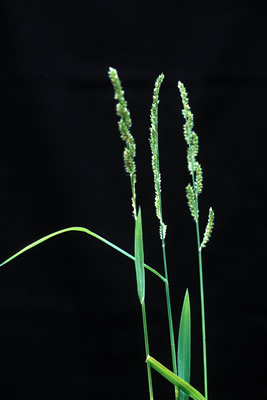Echinochloa colona

Latin name
Echinochloa colona (L.) Link
Family
Poaceae
Common name
Jungle rice, awnless barnyard grass
Synonyms
Echinochloa colonum (L.) Link, E. crus-galli subsp. colona (L.) Honda, Panicum colonum L. (basionym), P. cumingianum Steud., P. zonale Guss., Milium colonum (L.) Moench, Oplismenus colonus (L.) Kunth
Geographical distribution
Asia: China and Japan.
South and Southeast Asia: Bangladesh, Cambodia, India, Indonesia, Lao PDR, Malaysia, Myanmar, Nepal, Pakistan, Philippines, Sri Lanka, Thailand, and Vietnam.
Rest of the world: Australia, Bolivia, Botswana, Costa Rica, Ecuador, El Salvador, France, Fiji, Guatemala, Honduras, Iraq, Italy, Kenya, Mexico, Nicaragua, Paraguay, Peru, Portugal, Senegal, Spain, Tanzania, Uganda, United States, Venezuela, West Africa, and Zambia.
Morphology
A tufted annual grass, up to 60 cm tall.
Stem: reddish purple or green, ascending to erect, without hairs.
Leaf: linear, 10−15 cm long, basal portion often tinged with red; ligule absent.
Inflorescence: simple, ascending racemes, green to purple, about 5−15 cm long; spikelets subsessile 1−3 mm long.
Biology and ecology
Echinochloa colona flowers throughout the year and is propagated by seeds. Seeds have a short dormancy period.
It can be present in large numbers and responsive to nutrients. Prefers moist but unflooded conditions and is a problem mainly in upland and rainfed lowland rice fields rather than in flooded fields.
Agricultural importance
It closely "mimics" rice in the vegetative growth stage and is a severe competitor of rice.
It is a host of diseases such as tungro and rice yellow dwarf. It can be used as a palatable fodder for milking animals and water buffalo.
Management
Cultural control: flooding; hand weeding or use of a hoe during early growth stages.
Chemical control: preemergence application of oxadiazon or pendimethalin or postemergence application of cyhalofop, butachlor, and fenoxaprop can be effective.
Selected references
- Galinato I, Moody K, Piggin. CM. 1999. Upland rice weeds of South and Southeast Asia. Manila (Philippines): International Rice Research Institute. 156 p.
- Halfliger E, Schloz H. 1980. Grass weeds 1. Basle (Switzerland): Ciba-Geigy Ltd. 142 p.
- Holm L, Pancho JV, Herberger JP, Plucknett DL. 1979. A geographical atlas of world weeds. New York (USA): John Wiley & Sons, Inc. 391 p.
- Mew TW, Fabellar NG, Elazegui FA. 1980. Ecology of the rice sheath blight pathogen: parasitic survival. Int. Rice Res. Newsl. 5:16.
- Michael PW. 1978. Notes on Echinochloa in the Philippines. Philipp. J. Weed Sci. 5:16-18.
- Moody K. 1989. Weeds reported in rice in South and Southeast Asia. Manila (Philippines): International Rice Reseach Institute. 442 p.
- Nirmal DJ, Jeyarajah R. 1992. Role of weeds as symptomless carriers to rice tungro virus. Madras Agric. J. 79:663-664.
- Paller Jr. EC, Valente FV, San Gabriel R. 1980. Field evaluation of different weed control approaches in transplanted tomatoes. In: Weed Science Report 1978-1979. College, Laguna (Philippines): Department of Agronomy, University of the Philippines Los Baños. p 76-79.
- Pancho JV, Obien Sr. 1995. Manual of ricefield weeds in the Philippines. Muñoz, Nueva Ecija (Philippines): Philippine Rice Research Institute. 543 p.







